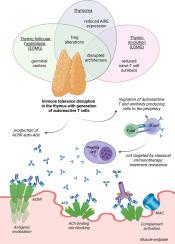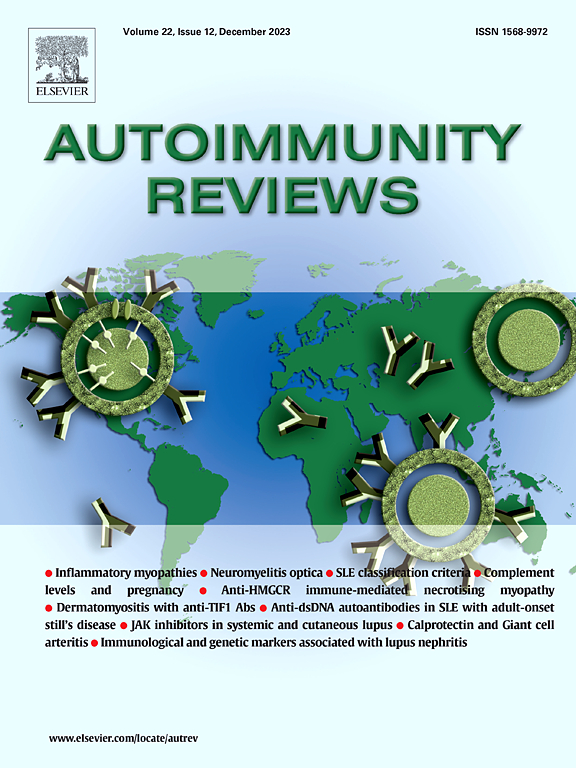Myasthenia gravis with antibodies against the AChR, current knowledge on pathophysiology and an update on treatment strategies with special focus on targeting plasma cells
IF 8.3
1区 医学
Q1 IMMUNOLOGY
引用次数: 0
Abstract
Myasthenia gravis (MG) is an antibody-mediated autoimmune disorder where the neuromuscular transmission is impaired, causing symptoms of skeletal muscle weakness and fatigue. The presence of autoantibodies against the muscle nicotinic acetylcholine receptor (AChR) is the most prevalent cause of MG. Abnormalities in the thymus are common in AChR-MG, and thymectomy has proven to be therapeutically beneficial. Up to 30 % of AChR-MG patients have also thymoma. Moreover, patients with thymoma without MG are more prompt to develop MG compared to the general population.
Autoantibodies in AChR-MG damage the postsynaptic membrane of the neuromuscular junction (NMJ) and cause muscle weakness by impairing synaptic transmission because of the depletion of the AChRs and destruction of the NMJ. The pathogenic autoantibody levels vary greatly between patients. In contrast, in individual patients changes in autoantibody levels correlate well with disease severity. A small selection of patients has been used to exemplify the individual relationship between autoantibody levels and disease progression. The study of the effector functions of the autoantibodies and the compensatory mechanisms at the NMJ are important to select the best treatment strategy for each patient. Even though classical immunomodulatory treatments are effective in many patients, around 10–20 % of patients do not respond to current therapies. This may be attributed to the production of autoantibodies by different circulating cells including mature B and long-lived plasma cells, which are resistant to most commonly used immunosuppressive drugs. Hence, novel therapies specifically targeting plasma cells might be a suitable therapeutic approach for selected refractory patients.

针对AChR抗体的重症肌无力,当前的病理生理学知识和治疗策略的更新,特别关注针对浆细胞。
重症肌无力(MG)是一种抗体介导的自身免疫性疾病,其中神经肌肉传递受损,引起骨骼肌无力和疲劳的症状。肌烟碱乙酰胆碱受体(AChR)自身抗体的存在是MG最常见的原因。胸腺异常在AChR-MG中很常见,胸腺切除术已被证明是有益的治疗方法。高达30% %的AChR-MG患者同时患有胸腺瘤。此外,与一般人群相比,没有MG的胸腺瘤患者更容易发生MG。AChR-MG中的自身抗体损伤神经肌肉连接处(NMJ)的突触后膜,由于achr的耗竭和NMJ的破坏,通过损害突触传递导致肌肉无力。不同患者的致病自身抗体水平差异很大。相反,在个体患者中,自身抗体水平的变化与疾病严重程度密切相关。一小部分患者被用来举例说明自身抗体水平与疾病进展之间的个体关系。研究自身抗体的效应功能和NMJ的代偿机制对于选择适合每个患者的最佳治疗策略至关重要。尽管经典的免疫调节治疗对许多患者有效,但大约10- 20% %的患者对目前的治疗没有反应。这可能是由于不同的循环细胞产生自身抗体,包括成熟的B细胞和长寿命的浆细胞,它们对最常用的免疫抑制药物具有耐药性。因此,针对浆细胞的新疗法可能是治疗难治性患者的合适方法。
本文章由计算机程序翻译,如有差异,请以英文原文为准。
求助全文
约1分钟内获得全文
求助全文
来源期刊

Autoimmunity reviews
医学-免疫学
CiteScore
24.70
自引率
4.40%
发文量
164
审稿时长
21 days
期刊介绍:
Autoimmunity Reviews is a publication that features up-to-date, structured reviews on various topics in the field of autoimmunity. These reviews are written by renowned experts and include demonstrative illustrations and tables. Each article will have a clear "take-home" message for readers.
The selection of articles is primarily done by the Editors-in-Chief, based on recommendations from the international Editorial Board. The topics covered in the articles span all areas of autoimmunology, aiming to bridge the gap between basic and clinical sciences.
In terms of content, the contributions in basic sciences delve into the pathophysiology and mechanisms of autoimmune disorders, as well as genomics and proteomics. On the other hand, clinical contributions focus on diseases related to autoimmunity, novel therapies, and clinical associations.
Autoimmunity Reviews is internationally recognized, and its articles are indexed and abstracted in prestigious databases such as PubMed/Medline, Science Citation Index Expanded, Biosciences Information Services, and Chemical Abstracts.
 求助内容:
求助内容: 应助结果提醒方式:
应助结果提醒方式:


